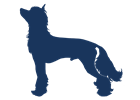

Chinese Cresteds
Chinese Crested Standard
|
The American Kennel Club Breed Standard for the Chinese Crested as published in 1991. General Appearance
A toy dog, fine-boned, elegant and graceful. The distinct varieties are born in the same litter. The Hairless with hair only on the head, tail and feet and the Powderpuff, completely covered with hair. The breed serves as a loving companion, playful and entertaining. Size, Proportion, Substance
Size - Ideally 11 to 13 inches. However, dogs that are slightly larger or smaller may be given full consideration Type and soundness are more important than size. A dog that presents the correct picture of a Crested is to be given equal consideration even if slightly over or under the ideal size range. Proportion - rectangular-proportioned to allow for freedom of movement. Body length from withers to base of tail is slightly longer than the height at the withers. The Crested's rectangular proportion allows for the smooth flowing gait. Substance - Fine-boned and slender but not so refined as to appear breakable or alternatively, not a robust, heavy structure. The Crested is a slender dog without being overly narrow, he is not delicate or fragile but is graceful, he is neither cobby nor stocky, anything resembling dwarfism is incorrect. HeadExpression - Alert and intense. This is not a head breed. Overall appearance is most important. The Chinese Crested is quite aware of what happens around him and is usually quite interested in his surroundings. His expression, due to the wide placement of the eyes, is rather soft and sweet. When the Crested is alert there is a lot of sparkle in the expression. Eyes - Almond-shaped, set wide apart. Dark-colored dogs have dark-colored eyes, and lighter-colored dogs may have lighter-colored eyes. Eye rims match the coloring of the dog. The eyes should not be too large, too round or too prominent. Eyes should not be set too close. Lighter colored dogs MAY have a lighter colored eye. The eye rims, in matching the dog's coloration, especially in the hairless variety, may be spotted, may be light, as in a pink or lavender dog, matching the rest of the dog's skin. Ears - Uncropped large and erect, placed so that the base of the ear is level with the outside corner of the eye. The actual angle of the ear set is not specified, just as long as the lower edge of the base of the ear is even with the outside corner of the eye. Therefore some dogs can have a rather high ear carriage and it is still correct. When very alert, some Crested's ears can come up so close as to almost touch (complete with wrinkles in the top of the head) and this is not a fault. Ears set too low are seen more frequently than too high. Nothing is said as to whether the ear is triangular and pointed, or more rounded (as the English ear) only that they must be erect. Both are correct. Rose, tipped or a drop ear is incorrect. Skull - The skull is arched gently over the occiput from ear to ear. Distance from occiput to stop equal to distance from stop to tip of nose. The head is wedge-shaped viewed from above and the side. The skull has a slight curve from ear to ear, and is NOT round and domey. The muzzle is equal in length from tip of nose to stop and from stop to occiput, but many are slightly shorter and very pretty. A broad, square muzzle or a really short one, whether broad or "foxy" is less than desirable. The wedge-shaped head should give a clean blended appearance. Stop - Slight but distinct. The stop is not so exaggerated as that of a Chihuahua, but is definitely more than that of a Collie. It can be seen and felt, but is not very deep. Placing your thumb into the stop should allow you to feel a slight blend into the skull. Muzzle - Cheeks taper cleanly into the muzzle. Cheeks should not be pouchy but flat and clean. The muzzle should not look "tacked-on". The line from the tip of the nose to the base of the ear is smooth. Nose - Dark in dark-colored dogs; may be lighter in lighter-colored dogs. Pigment is solid. In dark colored dogs the nose is usually black or dark brown, it can be self colored on light dogs. The nose must be a solid color. Lips - Lips are clean and tight. The Crested has no flews. Bite - Scissors or level in both varieties. Missing teeth in the Powderpuff are to be faulted. The Hairless variety is not to be penalized for absence of full dentition. In the Hairless variety bites should be given equal consideration against other Hairless and Powderpuffs. Along with missing teeth, the Hairless may also have crooked ones, especially a tusk-like canine. The gums must still be lined up in scissors or even position. Hairless may have teeth that are shaped different in that they are more pointed and narrower. They almost look like puppy teeth. Neck, Topline, BodyNeck - Neck is lean and clean, slightly arched from the withers to the base of the skull and carried high. To achieve the proper arch of neck, a certain amount of length is necessary. Cresteds at attention tend to arch their necks slightly more than is required. A short, stocky "bull" neck is incorrect. Topline - Level to slightly sloping croup. The neck should blend into the shoulders and topline. The layback of the shoulder slopes into a level back, which, in turn, rounds off by sloping gently into a slight croup. The croup lowers the tailset slightly. Body - Brisket extends to the elbow. Breastbone is not prominent. Ribs are well developed. The depth of the chest tapers to a moderate tuck-up at the flanks. Light in loin. Cresteds need enough substance and depth of body so they do not appear spindly. Cresteds are neither slab-sided nor barrel-shaped in the ribs. They are a smooth, well-developed but not overdone dog, with a tuck-up and a lighter loin area. Tail - Tail is slender and tapers to a curve. It is long enough to reach the hock. When dog is in motion, the tail is carried gaily and may be carried slightly forward over the back. At rest the tail is down with a slight curve upward at the end resembling a sickle. In the Hairless variety, two-thirds of the end of the tail is covered by long, flowing feathering referred to as a plume. The Powderpuff variety's tail is completely covered with hair. In motion the tail is usually out or up and MAY be carried up over the back. At rest, the tail usually drops. It should not be tucked, although the bravest Hairless will tuck when cold. They get cold easily in wind, air conditioning, etc. The plume may be long with a long, full crest or less so with a sparser crest. The puff tails are covered and may plume or feather. ForequartersAngulation - Layback of shoulders is 45 degrees to point of shoulder allowing for good reach. Shoulders - Clean and narrow. Elbows - Close to body. Shoulders and elbows should not be so tight and narrow as to restrict movement, yet not be floppy and loose. Legs - Long, slender and straight. Legs should not be so slender as to appear breakable nor so long as to appear out of proportion. Legs should be long enough to dispel any idea of dwarfism yet still retain the overall rectangular outline of the dog. Pasterns - Upright, fine and strong. Dewclaws may be removed. Pasterns have a very slight angle to give the spring to the step that makes for smooth gait. Feet - Hare foot, narrow with elongated toes. Nails are trimmed to moderate length. HindquartersAngulation - Stifle moderately angulated. From hock joint to ground perpendicular. Dewclaws may be removed. Angulation: moderate and complimentary to the front angulation to give the dog balanced movement and a smooth gait. Feet - Same as forequarters. CoatThe Hairless variety has hair on certain portions of the body: the head (called a crest), the tail (called a plume) and the feet from the toes to the front pasterns and rear hock joints (called socks). The texture of all hair is soft and silky, flowing to any length. Placement of hair is not as important as overall type. Areas that have hair usually taper off slightly. Wherever the body is hairless, the skin is soft and smooth. Head Crest begins at the stop and tapers off between the base of the skull and the back of the neck. Hair on the ears and face is permitted on the Hairless and may be trimmed for neatness in both varieties. Tail Plume is described under Tail. The Powderpuff variety is completely covered with a double soft and silky coat. Close examination reveals long thin guard hairs over the short silky undercoat. The coat is straight, of moderate density and length. Excessively heavy, kinky or curly coat is to be penalized. Grooming is minimal-consisting of presenting a clean and neat appearance. HAIRLESS: Crest, plume and socks on the Hairless are single coat, soft and straight. The crest on the Hairless may be anything from a strip of hair from stop to neck to a full head of hair, complete with face furnishings and ear fringes. Socks may be just on the feet and sparse (in keeping with the crest) or heavy Clydesdale-type reaching up to about the pastern or hock joint. The tail plume matches the crest and socks in density and length. Hair may be left on the face and ears of the Hairless, or it may be trimmed (including shaving) from the face and ears of both varieties. A Hairless with a heavy crest and furnishings is more likely to have body hair. It may be a strip down the back or perhaps on the hips or shoulders. This does not make the dog a Powderpuff. POWDERPUFF: The Powderpuff coat is a double and soft, silky outercoat. Excess, be it in the amount of coat, kink or curl is to be faulted. Sometimes humidity will bring out a wave in a coat; not all coats are absolutely straight. The coat should not be standoffish. Length is usually about knee-length or shorter. Coat length and density do vary in the Powderpuff. In some cases due to the weight of the hair on the ears they are trimmed. ColorAny color or combination of colors. The Crested is an interesting breed due to the infinite variety of colors and color combinations. Add to that the fact that they change color and "tan" or darken in the sun. They also sunburn easily, particularly the light colors. GaitLively, agile and smooth without being stilted or hackneyed. Comes and goes at a trot moving in a straight line. The phrase comes and goes in a straight line means simply no crabbing or sidewinding. The feet will come under the dog toward a point of balance, with legs in a straight line. The gait is smooth, not rolling. TemperamentGay and alert. Cresteds are happy, people-loving dogs and are especially so with their own people. They are very versatile. They are trainable and attentive, anxious to please. RING PRESENTATION: Cresteds are presented in the ring much like any other toy dog. They are judged on the table, and move rather fast. They need a bit of space to move out and show their ability to move correctly. |